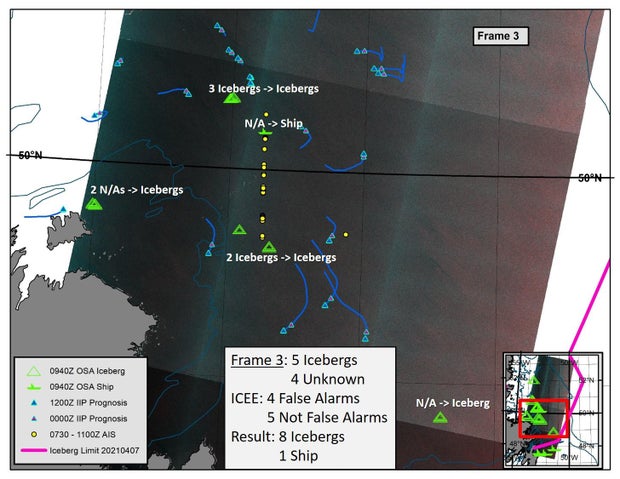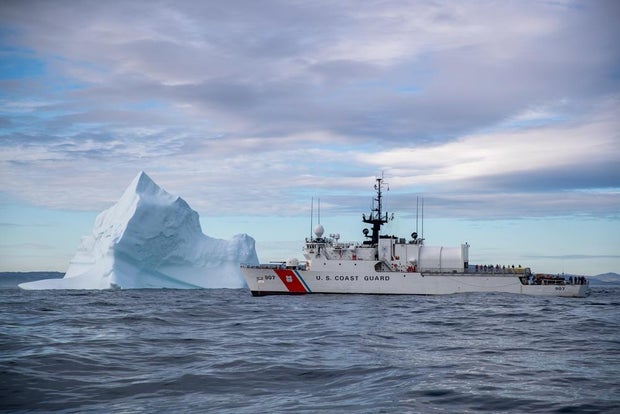[ad_1]
It was the “unsinkable ship” right until it wasn’t.
Ten minutes prior to the maiden voyage of the Titanic finished in calamity, a radio operator aboard the nearby SS Californian signaled that there was an iceberg in the ship’s path. The warning was dismissed, and the large collision that adopted charge in excess of 1,500 life, prompting a wave of maritime improvements: sonar and radar navigation functions, lifeboat drills and the development of the Intercontinental Ice Patrol (IIP.)
Now, 110 decades following the sinking of the Titanic, the U.S. governing administration is acquiring a new technological innovation which is made to detect and report icebergs to the maritime group.
“Procedure Titanic,” spearheaded by the Office of Homeland Security’s Science and Technological innovation Directorate, will fuse satellite-based radar imagery with ship reporting programs to permit the U.S. Coast Guard to discover glacial masses in the course of the North Atlantic Ocean in true time.
Delivered by U.S. Coast Guard
Floating icebergs like the one particular the Titanic struck on April 15, 1912, nevertheless pose navigational dangers today for ships, oil rigs and military property, claims Kathryn Coulter Mitchell, the DHS senior formal performing the responsibilities of the beneath secretary for science and know-how, advised CBS Information.
“The Titanic truly struck the iceberg at a latitude equivalent to the Massachusetts location,” Coulter Mitchell stated. “Those of us in this mission space you should not normally recognize just how far south, how commonplace the iceberg mission is.”
The 16-individual IIP is funded by 17 nations bordering the trans-Atlantic, but is operated by the U.S. Coastline Guard throughout ice time, from February by way of July.
The patrol originally relied on cutters deployed by the U.S. Coast Guard to survey icebergs but switched to plane monitoring following World War II. Now, the IIP pilots 9-day plane missions each two months.
Delivered by U.S. Coast Guard
“Procedure Titanic” will mark a “comprehensive departure from [U.S. Coast Guard’s] many decades of flying mounted-wing aircrafts to find icebergs,” stated Coastline Guard Commander Marcus Hirschberg with the International Ice Patrol. .
Furnished by U.S. Coastline Guard
“Aerial ice reconnaissance” routinely provides up to additional than $10 million in annual expenditures for the U.S. Coast Guard. Further than the rate tag, C-130J aircrafts that fly bi-weekly missions – around 500 plane hours per time – are also the U.S. Coastline Guard’s most remarkably sought right after aviation belongings.
“We’re heading to get a ton a lot more bang for our buck after we can use people plane hours for catastrophe response, counterdrug operations, migrant operations and other places,” Hirschberg added.
The U.S. governing administration has invested $4 million in “Operation Titanic” to day, with cash drawn from the Science and Technological know-how Directorate’s Research, Growth and Innovation fund.
And even though identical technologies are at the moment used by the U.S. government in rescue missions and flood response, the new satellite technology – which will attract images from the European Area Agency satellites, U.S. business companies and Canada’s RADARSAT Constellation – will be the first of its sort to entry international satellite data.
The satellite-based radar imagery continues to be absolutely operational in darkish, overcast ailments that usually stop ordinary plane operations. Hirschberg called it a “sport-changer for forecasting the period.”
“When the Coast Guard arrived to us with this, the hope was to prevail over the troubles with [technology] that is immune to darkness and overcast, so we can see more upstream of the transatlantic shipping lines than we at any time have been just before to concern lengthier-phrase predictions,” Coulter Mitchell stated.
“For forecasting, we’re searching at icebergs that are way far North that we are not able to achieve with aircrafts, even flying from St. John’s Newfoundland,” explained Hirschberg.
“A lot of periods there’s a mechanical problem with the aircraft, inclement weather conditions, or we are not able to get the hangar doorway open up mainly because of high winds. So we do get rid of a large amount of chances to fly,” he additional.
Glaciers in elements of the North Atlantic are melting so promptly that modifications can be seen from room. The most up-to-date “Arctic Report Card,” revealed by the Nationwide Oceanic and Atmospheric Administration (NOAA), discovered the region warms two times as speedy as the rest of the Earth, ensuing in the immediate decline of ice include.
“We see so a lot season-to-period variability,” Hirschberg instructed CBS Information. “In 2019, we experienced 1,500 icebergs move south of 48° North latitude – about in which the Titanic sank. In 2020, we experienced a single iceberg go that restrict.”
U.S. Coast Guard officials foresee working with satellite pictures will help the department navigate improvements brought on by a transforming local climate.
The Global Ice Patrol is slated to test-operate “Procedure Iceberg” for two several years, starting in 2023 just before launching the software.
[ad_2]
Supply backlink





